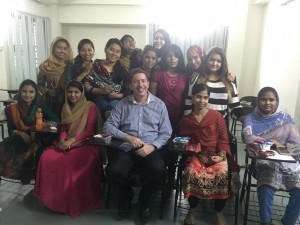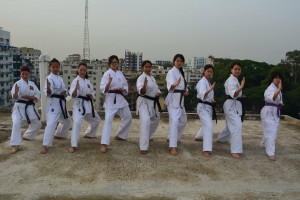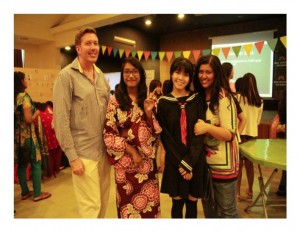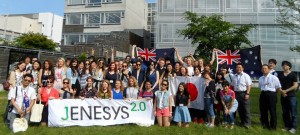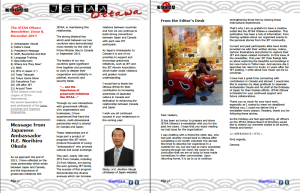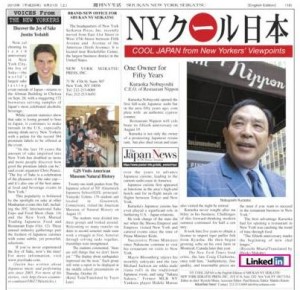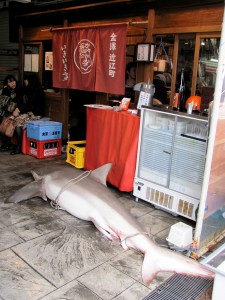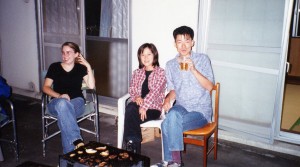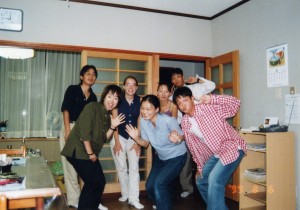By Mark Flanigan, Nagasaki (2000-04)
As a JET alumnus, I look back fondly on the four years I spent living and teaching in Nagasaki Prefecture. Serving on JET was, quite literally, one of those “life-changing” experiences, as it confirmed my career path in the direction of public service and global education. In the 15 years or so since my time in Nagasaki, I have been lucky to have had international roles in the U.S. government, in higher education, and at a private, Japan-focused non-profit foundation. I was even fortunate enough to return to Japan a second time, to earn my MA in Peace Studies in 2012 through the Rotary Peace Center at International Christian University (ICU) in Tokyo. Later, I served in a variety of roles in Manhattan with JETAANY between 2012-16.
My most recent career stage brought me back into the classroom, albeit in a different role and a new part of Asia for me. I am currently serving as a WorldTeach Fellow volunteer in Chittagong, Bangladesh, at the Asian University for Women (AUW). It has been both a challenging and rewarding transition back into teaching, as I felt a bit rusty in the beginning and took a bit of time to get back in the groove. Also, my main experiences with Asia had been almost entirely focused on Japan, China, and Korea. For me, South Asian history and culture was something I knew very little about up until a couple of years ago. Being here, I realized how comparatively little I knew about the diverse cultures of the Indian subcontinent of Asia. Nonetheless, it has proven to be an extremely rewarding transition, personally as well as professionally.
Me with some of my Pathways students in Bangladesh
Through a friend in New York City, I had first learned about AUW back in 2015. She had been a WorldTeach Fellow here a few years before, volunteering and having a really significant educational and cultural experience. The more I heard about her time in Bangladesh, the more I thought it sounded like a great opportunity to get back in the classroom while making a positive contribution to education for women at a significant institution like AUW. While I definitely enjoyed my four years in Manhattan, working as a Program Director with the Japan ICU Foundation (日本国際基督教大学財団), I also felt ready to take on a new challenge. I applied and was happily accepted as a new volunteer with WorldTeach, and assigned to AUW for the 2016-17 academic year.
AUW was founded in 2008 as a regional hub to help educate underprivileged women throughout different regions of Asia and the Middle East. With a liberal arts curriculum that promotes critical thinking and women’s empowerment, it is a truly encouraging place for young women who have faced numerous challenges in life due to poverty, gender bias, and sectarian conflict. With 600 students (and over 400 alumnae) from 15 different countries, including Nepal, Bhutan, Myanmar, Vietnam, Cambodia, Sri Lanka, Afghanistan, Pakistan, Syria, Palestine, and others, AUW is an amazingly diverse place. The dynamic environment, small class sizes, and daily interaction of people with many different ideas, perspectives, and cultures makes it an esteemed center of higher education in South Asia.
However, I almost missed my chance to be here. Less than one month before I was due to arrive at AUW, we heard the news of the terrible attack in Dhaka, the capital city of Bangladesh. All I knew was that international residents of the city (and their local friends and colleagues) had been targeted specifically in a vicious terror strike. The attackers, while a definite minority in terms of the general population, were sending a very clear and deadly message. Although the attack did not take place in Chittagong, it was great cause for concern among both WorldTeach and AUW staff, as well as present and future volunteers. At that time, it was not clear whether we would still be able to serve in Bangladesh, or how the program might proceed. Many safety protocols would need to be analyzed and revised before a final decision could be made. In the end we were still given the option to come, which I was definitely happy to hear.
I have now been here for seven months, teaching two different groups of students over the autumn and now spring terms. My classes are part of the Pathways for Promise Program at AUW, which is the recently developed entry point for women who have not had as much formal preparation to succeed in higher education. Many of them have come as former workers from the garment factories of Bangladesh, while others are daughters of Grameen Bank loan recipients, refugees from the persecuted Rohingya community, as well as indigenous minorities from the Chittagong Hill tracts region. In addition to Bangladeshis, Pathways students have come from Afghanistan, Cambodia, and Myanmar. They will take classes for approximately one year in Reading and Writing as well as Listening and Speaking, and also study Math and IT while participating in Community Time and Social Mentoring workshops and events.

A lovely display of Bengali cuisine
If they complete the Pathways Program successfully and meet all the exam requirements, they will advance to the one-year Access Academy and then an additional three years of undergraduate study at AUW. In all, the successful ones will graduate in five years with their bachelor’s degree in hand. Against all odds, this is their big chance to earn their college degree. Without the encouragement and funding support to match their own amazing dedication, it would most likely be impossible. It will not be easy for them. Many are far away from home and spend almost all of their time on the small but secure campus. They live in dormitories with 2-5 students per room, eat in the dining hall, and take all their classes together, so there is very little time for privacy or quiet reflection. Nonetheless, they are very eager to learn and make the most of this unique opportunity they have been granted.
It goes without saying that my students inspire me each and every day. Teaching them is really one of the biggest joys of my life here, and in many ways takes me back to my first experience teaching overseas in Japan. Although those two times are separated by about 15 years and many more miles, there are also some interesting parallels between them. Of the many things I have discovered over my time here thus far at AUW, one of the most interesting has been the surprising number of existing connections here between Bangladesh and Japan. As a former JET who later studied at ICU and worked to promote increased U.S.-Japan ties, it’s been a really pleasant surprise to find out about and help to build on these great bilateral bonds of friendship.
The first one, I discovered quite by accident. In the early part of the autumn semester, I was walking in the hallway outside of my office when I heard the distinct counts of “ICHI, NI, SAN, SHIIII!!” emanating from the level above. Intrigued, I climbed the staircase up to the next floor and was surprised to discover the gymnasium filled with perfect rows of students. They were in straight lines, balanced in strict stances, with fists alternately chambered by their side and then thrust forward in a crisp motion I instantly recognized. My mind wandered back to our small dojo in Hirado City, Nagasaki, where I spent countless hours drilling in those very same “kihon” movements. I was curious to find out more, so I made arrangements to return and observe a longer class in session.
It was then that I met Ms. Maria Chakraboty, their instructor, a remarkable woman from Bangladesh who has achieved her 5-Dan rank in Shotokan Karate. Maria serves as a real inspiration to her students, as AUW’s Associate Director of Physical Education and Karate instructor. Maria grew up in Chittagong, the same city where AUW is based, and faced hardships of her own due to people judging her negatively by her gender. She was strongly discouraged by others in her pursuit of Karate, but through the encouragement of her instructors, she has achieved a remarkable number of accomplishments. For her students, Maria is a living, breathing example of a successful adult woman, who has faced down discrimination and has continued her own personal growth through embracing the Japanese art of Karate. She has been able to impart her wisdom and experience to hundreds of young students through the years. Such is the wonderful environment of a cross-cultural, liberal arts university like AUW.
Maria (Center) training with some of her AUW students
In addition to Karate, there are other tangible bonds of kizuna between AUW and Japan. Attending the University’s Club Fair this past autumn, I was happy to learn that AUW students are involved in all kinds of social and academic club activities. Similar to Japan, students here balance their time between formal classes and organized clubs, like Model UN, Animal Welfare, a variety of sports, and other pursuits. Most interestingly to me, I discovered that there is a very active group of students on campus who are involved in the AUW Japan Circle Club! They are extremely genki and know an amazing amount of things regarding Japanese culture. They study Japanese on their own (as it is not taught here), read manga, watch anime, and even make their own kimono and other clothing by hand! Upon meeting them, I shared my experience as a JET alumnus and former ICU graduate student. They asked me to serve as their faculty advisor, to which I most happily agreed!
With some of the AUW Japan Circle Club students (and their hand-made clothing)!
I have been very happy to be working with them on various projects here this term. Most specifically, we have planned and organized a Japanese book drive among some of my colleagues and friends in Japan and Hong Kong. Through their kind and generous help, we have now received about seven boxes full of manga, books, magazines, language textbooks, and Japanese-English dictionaries from abroad! All of these were donated to the AUW library, so students can access them freely anytime. As none of our students have been able to visit Japan as of yet, they really love the chance to see any kind of “hon mono” firsthand. One Tokyo friend in particular also sent a variety of delicious Japanese candies, which were a big hit with the students! We are still interested in receiving any other items from Japan, if anyone would like to donate. Additionally, the students performed a number of Japanese songs (in Japanese) and dances for our recent Lunar New Year Festival. We hope to develop exchange partnerships with AUW and universities in Japan, in order to offer study abroad opportunities in both directions. Interestingly, at least one AUW alumna is now studying in Japan, earning her Master’s degree at the United Nations University (UNU) in Tokyo!
Lastly, there is a very robust level of support for AUW in Tokyo. As part of the global support network for AUW students, a number of highly-accomplished and very influential donors make up the “Friends of AUW Japan” organization. Among them is Ms. Kathy Matsui,Vice Chair of Goldman Sachs Japan,who has a long and deep connection to AUW. In 2007, she was chosen by the Wall Street Journal newspaper as one of the “10 Women to Watch in Asia” for her work on the “Womenomics” theme, and serves as a board member of the AUW Support Foundation. Ms. Matsui and her husband, Mr. Jesper Koll, have been major donors to AUW since its inception, and they continue to look for ways to promote exchange between AUW and Japanese universities and companies. In addition, First Lady Akie Abe serves as an official Patron of AUW and has been actively involved with a number of fundraising efforts on behalf of the university in Tokyo over the past few years. Lastly, AUW has enjoyed very generous support through the past several years from a number of Japanese companies like HITACHI, MITSUI & CO., TOSHIBA CORPORATION, and UNIQLO.
First Lady Akie Abe (center) and Ms. Kathy Matsui (second from right)
In conclusion, I would say my time here in Bangladesh has been a wonderful journey thus far. In many ways, it’s a completely new (and sometimes bumpy) experience for me, living in South Asia and in a developing, Muslim-majority country for the first time. Culturally, it’s much different than what I was used to, but that’s been a good opportunity to broaden my own horizons and question my preconceived notions about life as well. My students in the Pathways for Promise Program specifically, and AUW students in general, have taught me so much and really inspired me through their own energy, resilience, and desire to learn. As a nice coincidence, this latest chapter in my career also brings me back to teaching and to Japan in many ways. I am happy to have so many “natsukashii” moments here, to help teach these remarkable young women, and also to be in a position to try and advance the relationships between people in Bangladesh and Japan. In some ways, it’s the most unexpected yet personally satisfying addition to my time here at AUW. I’m happy to make the most of all these fortuitous connections during my time here in Bangladesh and beyond.
=================================================================================
Mark Flanigan is currently a WorldTeach Fellow volunteer in Chittagong, Bangladesh, at the Asian University for Women (AUW). Mark served as an ALT in Nagasaki Prefecture from 2000-4, and later studied for his MA in Peace Studies as a Rotary Peace Fellow at the International Christian University (ICU) in Tokyo from 2010-12. After graduating from ICU in 2012, he spent four years working for the Japan ICU Foundation in NYC. He has also held leadership roles in the JET Alumni Associations of both New York and Washington, DC. He can be reached at markinmitaka(at)gmail.com

Nathaniel Simmons (Nara-ken, 2007-2009) is currently is currently a communication faculty member at Western Governors University and lives in Columbus, OH, USA. He teaches a variety of intercultural, interpersonal, and health communication courses. He has researched and published several scholarly articles regarding privacy management between foreign English teachers and Japanese co-workers in Japan.
“Something of and in Japan, [is that] it doesn’t matter about who you are. Your health is never private. They [Japanese] don’t see health as a privacy thing. So you know, if you want to keep it private, don’t talk to anyone about it.” – Alice
After having my own interesting health experiences in Japan, I remained curious as to what other ALTs experienced. Therefore, I went back to Japan and interviewed 10 ALTs (5 women and 5 men) about their medical encounters. I quickly learned that it wasn’t “just me.” I heard a lot of strong comments such as Alice’s. In fact, everyone managed their medical privacy to some extent. I share one story below:
“There were no barriers. Every person in the village, every school, you know everyone in the Board of Education, the whole school knew that I broke my leg and what days I was going to the hospital, and medication I’ve been given. There’s no quiet, patient confidentiality.”
Meet “Jamie.”
An ALT in rural Japan like most of the ALTs employed by ALT organizations. She loved her job, teachers, and students. She worked hard and was enthusiastic about English education.
After breaking her leg, everyone knew. But how? She explained:
“It starts off with the supervisor who tells the Board of Education, they then informed the schools, and well, the schools tell the teachers, and the students ask, they tell the students, the students tell the parents, the parents go to the restaurant down the road and tell them, and the whole village knows.”
For Jamie, living in rural Japan meant that she wasn’t able to obtain her desired privacy levels. Suddenly, she was not just the “foreigner,” but the “foreigner with the broken leg.” She was the talk of the town. Even her prescribed medication wasn’t a secret. At the same time, Jamie was a “good sport.” She laughed about the spectacle of her situation. However, this somewhat uncomfortable experience influenced later health encounters.
After having appendicitis, Jamie didn’t want to go to the hospital as her doctor suggested. She told her Board of Education (BOE) that she just needed to go home and “sleep it off.” However, her tale doesn’t end there.
Although somewhat comical to Jamie, she saw this as a privacy violation. After-all, this isn’t a situation Jamie would have experienced in her home country. People now knew information she didn’t want them to know. She attempted to not have her school involved, but things didn’t go the way she planned. In reality, the doctor’s decision potentially saved her life, but, at the same time, Jamie perceived her privacy to be violated.
This sentiment was echoed throughout stories of ALTs’ health experiences. Someone told someone, who told someone else…and before they knew it, everyone knew information about them and, yet, they didn’t know much about anyone else.
How did ALTs manage their privacy in this study?
Withdrawing from workplace relationships (i.e., not talking to co-workers), lying, intentionally or through omission, and relying on the help of a non-workplace related friend (i.e., another ALT, Japanese friend, etc.) were the three most common strategies shared. For example, if an ALT was on medication that they didn’t want their co-workers to know about, they might say it was an “allergy” pill. If any ALT felt their privacy was violated, they stopped talking to co-workers…sometimes about everything.
Questions for you:
- To what extent was privacy a concern for you? Why/why not?
- How did you protect your secrets? (It doesn’t just have to be health!)
- What do you recommend to current ALTs regarding their private health information? Future ALTs? Do you agree with Alice?
This blog post is an adaptation of the scholarly article: Simmons, N. (2012). The tales of gaijin: Health privacy perspectives of foreign English teachers in Japan. Kaleidoscope: A Graduate Journal of Qualitative Communication Research, 11, 17-38. Retrieved from http://opensiuc.lib.siu.edu/kaleidoscope/vol11/iss1/3/
Writer Graham Shelby (Fukushima 1994-97) recently teamed up with The Butcher’s Apron Radio Show to produce this full-on audio story (music, sound EFX, the whole thing) about a distinctly JET experience.
“The Asakawa Christmas Party” tells the true story of a complicated Christmas party Graham and a few other American JETs attended at a Japanese elementary school. It was complicated because…
a.) it took place on the anniversary of the Pearl Harbor attack.
and…
b.) the teachers asked them to teach “a traditional American Christmas dance.” (FYI – there aren’t any).
How’d it turn out? Doozo.
The story was produced as part of Selfridge and Co’s Reasons to Believe series of original Christmas tales. Graham has a few more Japan stories here.
JENESYS 2.0: What’s It Like?
Posted by Eden Law (Fukushima-ken, 2010-2011), JETAA NSW committee member and a JENESYSTS, apparently. He even has the certificate to prove it! This piece went out in the Sydney Japanese Consulate newsletter in August. If you are considering volunteering for the JENESYS programme and would like more information on what it’s like, he’s happy to have a chat.
This year I was fortunate enough to be selected as a supervisor of the Australian contingent for the JENESYS programme, a youth exchange programme administered by JICE (Japan International Cooperation Center). Made up of 19 participants (or Jenesysts, as the JICE director dubbed us at the end of our tour) between the ages of 18 to 24, and hailing from Queensland, New South Wales, Victoria and Western Australia, our packed, 9-day schedule (June 23rd – July 1st) covered Tokyo and various places in Hokkaido. Accompanying us were the smaller New Zealand group, and also our guides from JICE. As JENESYS 2.0 covers different themes for each group, the theme for ours was Mass Media (General – Journalism, Multimedia, bloggers).
Our programme schedule was quite eclectic and packed, travelling extensively on buses from one location to the next, which required an early morning start (sometimes at 5am) in order to get through it all. In Tokyo we got behind the scenes at NHK Studio’s English language department newsroom, as well as the more publicly accessible NHK Studio Park News, where visitors can observe how various television programs are produced. We also visited Edo Tokyo Museum, with its wonderfully elaborate scale models, and Senso-ji in Asakusa on the second last day of the programme. Hokkaido’s programme was focused more on technology, with a tour of Bibai city’s “snow technology” facilities (a scientific and rather detailed description of the principles is available here) and a visit to the Hokkaido Institute of Technology, with a stop for lunch at Arte Piazza Bibai, a peaceful sculpture park containing artworks by Kan Yasuda. But the definite highlight for everyone was the homestay with local Sapporo families, where many participants enthused about their individual experiences that included food, culture and traditions – or “authentic Japan”. Lastly, participants were then asked to formulate and present a plan on how they would use their experiences on the programme to promote Japan, and to contribute generally to a deeper interest in the country at a local level.
Travelling with a young and especially energetic group of youths and young adults certainly made for a lively (and busy) trip. As the majority had never been to Japan before (and some had left Australia for the first time), it was very interesting and enjoyable to see Japan through their eyes and perspective, and re-discover what had sparked my own love for Japan, and to share my own thoughts as well. And I was quite impressed with the overall quality of the participants who were chosen: quite a few spoke a second, even third language, and there were writers, musicians and artists. Of course, they were rambunctious as can be expected (the phrase, herding cats comes to mind), but they displayed a high sense of curiosity and adventure about their environment. As the Australian group were university students who were involved in arts, communications and online media disciplines, it would have been a great opportunity to have included in a “Mass Media”-themed programme, greater exposure to things that were related to their background. For example, introducing them to journalists, artists or students studying the same disciplines, and who utilise the online social media environment to communicate and facilitate cultural ideas and modern Japanese culture. As young adults, our participants used their free time to not just shop and have fun, but to experience Japan and its culture through all their senses, which they will report and disseminate back home to their friends and family. Every aspect of Japanese life is interesting – from the smallest details of crossing the street, to wearing a yukata for the first time. The best publicity is to allow them to have fun and communicate that enjoyment and fun to the world. More people will then be attracted to Japan, and will come to experience this for themselves.
As for my duties as a supervisor, much wasn’t known beforehand, as information was scant (on all aspects – a detailed schedule was not available until the start of the trip), but I was certainly kept busy with performing numerous tasks during the day, which would include daily temperature checks of participants (to catch impending illness), marshalling the group (or locating stragglers distracted by the Japanese retail wonderland), and helping our JICE guides, who had more responsibilities and worked far harder than us supervisors. It would have been desirable to have some information upfront, such as crucial details like the gift exchange ceremonies, which caught us shorthanded as this was only revealed to us the day before the event – luckily our Tokyo hotel was next to a supermarket that sold Australian wines. Adaptability and resilience are definitely required of a supervisor, as there can be changes and last minute information that one has to respond to quickly. Both myself and my NZ counterpart certainly came to appreciate Japan’s very reasonably priced alcohol after hours!
All in all, it was quite a packed and enjoyable trip, especially the aspects where the participants were able to enjoy interacting with local people: from chatting to a group of elementary students on excursion at the Edo Museum, and being part of the lives of families during home stays. Japan’s most easily recognisable asset, its culture and traditions, were also highly popular, and the all-too-brief introductions left us wanting more. Acknowledgement must be made of our JICE guides who work tirelessly and were endlessly helpful and generous with their knowledge and time, and who ensured we got to our next appointments, and whose patience we must have tested time and time again. Of course our host families and all the friends we made on the trip, who truly made Japan come alive beyond what we see and read, are remembered with warm regard. And finally, many thanks and appreciation goes to the Japanese government for creating this incredible opportunity for others to come and experience their country. The potential of the JENESYS programme is great, as it focuses on building a relationship with youth of Asia Pacific, and as JENESYS 2.0 continues to improve and develop, positive things lie ahead in the future.
JETAA Ottawa Newsletter – December 2013
Via JETAA Ottawa. Posted by Gemma Villanueva (Fukushima 2008-11), the past editor for the JETAA Ottawa Newsletter.
The latest digital issue of the JETAA Ottawa Newsletter can be viewed here: http://us4.campaign-archive2.com/?u=4d0d4aa436ad87ff44921adec&id=80f9a73363
What’s in this issue?
Download past issues here:
http://us4.campaignarchive2.com/home/?u=4d0d4aa436ad87ff4492
1adec&id=13d4251245
JQ Magazine: Hark! The Herald KFC
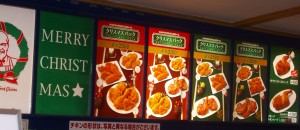
Good tidings we bring for you and your kin /
Good tidings for chicken and a happy new year. (Jarrad Skinner)
By Jarrad Skinner (Toyama-ken, 2007-11) for JQ magazine. Jarrad is an instructional designer for interactive online courses in the mental health field. Otherwise, he’s obsessed with game design, comedy, and hip-hop. After being born on Long Island, educated in Manhattan, and confused in Japan, he lives in Brooklyn. You can find him on the dance floor.
It’s Christmas Eve and KFC is out of chicken. This can’t be life. We didn’t make reservations, so we can’t have any chicken. It’s one thing to walk into KFC on Christmas Eve to get a bucket of greasy poultry parts, but it’s a whole other indignity to be told you can’t have any. Biscuits and sides will have to do.
As many of you probably already know, KFC pulled off some kind of unholy cross-cultural coup to convince a good portion of Japan that KFC and Christmas go together like peanut butter and jelly. Well, that is, if you’re American, PB&J go together naturally. And that’s really the point that I had to stubbornly learn again and again in Japan: nothing naturally goes with anything. We make it up as we go and then get used to our inventions. We become so used to them, we call them natural or traditional or don’t call them anything at all because we take them for granted like pizza with tuna fish topping.
If there’s one thing we take for granted more than readily available pairings of foods, it’s family. You might be a jackass today, but you expect family to be there tomorrow anyway. And if there’s one message that’s been drilled into our heads by the seasonal onslaught of holiday songs and shows, it’s “Go home to your family!” Every memory of every sitcom holiday special featuring some selfish oaf learning the lesson that the real present at Christmas is family reminds me that as the holidays approach in Japan I feel…unnatural.
Justin’s Japan: Discover the Joy of Sake
By JQ magazine editor Justin Tedaldi (CIR Kobe-shi, 2001-02) for Shukan NY Seikatsu. Visit his Examiner.com Japanese culture page here for related stories.
Now celebrating its 10th anniversary in New York City, The Joy of Sake—the world’s largest sake tasting event outside of Japan—returns to the Altman Building in Chelsea on Sept. 26, with a staggering 172 breweries serving samples of Japan’s most celebrated alcoholic beverage.
While current statistics show that sake is losing ground to beer in Japan, it continues to make inroads in the U.S., especially among drink-savvy New Yorkers with a palate for the record 384 premium labels to be offered at the event.
“In the last 10 years the amount of sake imported into New York has doubled as more and more people discover how good the premium labels can be,” says event organizer Chris Pearce. “The Joy of Sake is a celebration of the pleasures of the sake cup—and it’s also one of the best annual food and beverage events in New York.”
This popularity is bolstered by the spotlight on sake at other Manhattan events this fall, including the JFC International Sake Expo and Food Show (Sept. 14) and the New York Mutual Trading Japanese Food and Restaurant Expo (Oct. 12). These annual industry gatherings pair the freshest of Japanese cuisines with some subtle, yet powerful, selections.
If you’ve never experienced The Joy of Sake, now’s the time! For more information, visit www.joyofsake.com.
Sister City Ties Ep #1: ALTs of the JET Program
Eliot Honda (Ehime-ken, 2009-2012) has started a unique video series on Sister City Ties in which he interviews current and former JETs:
JQ Magazine: Same-sama, Party of One
By Leah Zoller (CIR Ishikawa-ken, 2009-11) for JQ magazine. Leah lives in Kanazawa, where she works as a writer and web administrator for The Art of Travel. In her spare time, she writes I’ll Make It Myself!, a blog about food culture in Japan and curates The Rice Cooker Chronicles on JETwit.com.
I live and work not too far from Omicho Market, and as a result, I see a lot of “Kanazawa’s Kitchen” and its back alleys in all seasons. I particularly like passing through in winter when the crabs are set outside the fish sellers’ stalls in the morning, the steam rising off their Styrofoam crates like a cloud in the cold air.
According to my coworkers, Omicho Market was once narrow and dirty, the way one expects a fish market to be. Since being renovated, Omicho, with its wide paths, incense to cover up the scent of fish, and ice blocks to relieve the summer heat, really fits with the tone and charm of our little city on the sea. Of course, the site is popular with tourists, but locals—myself included—actually shop there, since the variety and price of produce and seafood is often better than it is at the supermarkets. Every visit there is like a culinary adventure to me: What will be on sale today? Will the price of persimmons have dropped? What new squash varieties are the farms in the Noto growing?
Even Omicho, whose weaving roads I know like the back of my hand, has its surprises. One weekend in early winter (and winter comes early to Kanazawa), my husband and I were walking past one of the market’s side entrances when something caught my eye. I couldn’t quite process what I was seeing at first—was that a person was lying on the ground in front of one of the restaurants?
The figure on the ground was about my height, but slowly the realization that it wasn’t a person sank in. No, it wasn’t a person at all—it was a dead shark.
Hibari-sensei: 2012 Japan-America Grassroots Summit
Jen Wang (Miyagi, 2008-09) is a lab tech in Dallas and a writer for the Japanese music sites, JRock247 and NekoPOP. Her love of cosplay and her junior high school students inspired the name for her own blog about Japan, Hibari-sensei’s Classroom.
Last August, I had the opportunity to be part of a great opportunity for cultural exchange. The skills I acquired came in handy, as North Texas hosted a delegation of over 150 Japanese visitors for the 2012 Japan-America Grassroots Summit. The Summit was inspired by the friendship between John Manjiro Nakahama and Captain William H. Whitfield, which would lead to official relations between the United States and Japan and a 171-year-old bond between the two families. The John Manjiro Whitfield Commemorative Center for International Exchange and the Japan-America Society of Dallas/Fort Worth worked together with fifteen cities (which included my hometown) to give the visitors an unforgettable experience.
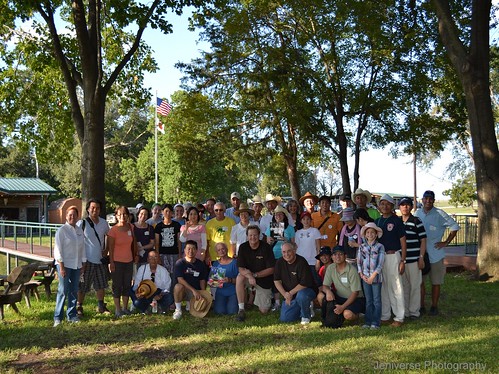
Click here to read about my experience with the Summit.
Hibari-sensei: Coming Full Circle with Sister Cities and JET
Jen Wang (Miyagi, 2008-09) is a lab tech in Dallas and a staff writer for the Japanese music website Purple SKY. Her love of cosplay and her junior high school students inspired the name for her own Japanese pop culture blog, Hibari-sensei’s Classroom.
This past March, I had a very rare opportunity: a couple of my former students were going to visit my hometown through the Sister Cities exchange program. I had been waiting for this since I ended my JET career, and because the last two student trips were canceled, I was extremely excited. Not only did I get to see how my students had grown and (hopefully) become more proficient in English, but the tables were now turned. I got to show them my home and my life. Without the Sister Cities program, I would have never become interested in being a JET and so I felt like in helping my family host a student, I had taken another step in my journey of cultural exchange. It’s been an adventure going from exchange student to assistant English teacher to host sister.
My first trip to Japan (real trip and not an overnight layover) happened through the Southlake Sister Cities Youth Ambassador Program. Although 19 made me technically too old to be considered a “youth”, my parents managed to convince the organization to tag along with my brother and the other high schoolers. I was nervous because it would be the first time I’d be out of contact with my family for more than a couple of days. On top of that, my finger had gotten a horrible infection before the trip. It felt as though I was going to be on my own. That turned out to be not true at all.
My host family, as well as the individuals overseeing our trip, made me feel at home. I fell in love with Tome, which was large enough to have different things to do (like shop, learn kendo, listen to music at a pub) but small enough to experience the peaceful solitude of the countryside. One of the days I met an American woman who was an assistant English teacher. She encouraged the high schoolers who were eating lunch with us to speak English. I remembered that she came to Tome through the JET Programme, and I saw that as my ticket to return to Japan.
Click here to read the rest of this post
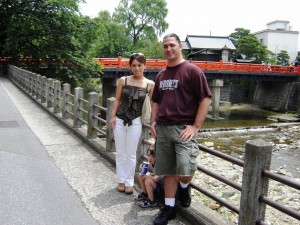 By John McGee (Nagano-ken, 2004-05) for JQ magazine. John is the Tampa Regional Representative for the Florida JET Alumni Association, and the founder of Tampa Natsu Matsuri, a free annual event organized by local residents with an interest in Japan.
By John McGee (Nagano-ken, 2004-05) for JQ magazine. John is the Tampa Regional Representative for the Florida JET Alumni Association, and the founder of Tampa Natsu Matsuri, a free annual event organized by local residents with an interest in Japan.
The balmy breeze blew in through the screened doors of our house, floating the sheer curtains in soft billows. Late May in southern Nagano is damp…it’s always damp on the wet side of the Alps. But being from Florida, this was comfortable weather.
My good friend was visiting from America. He’d made quite a stir in our sleepy town striding around with his seemingly angry Native American scowl way up there brushing two meters, from which nearly a meter of black tresses flowed down like raven waterfalls.
We were watching the shadows slip up the mountains across from our home when the phone rang. It was our friend Sayaka. “The fireflies are here!” she said excitedly. “Want to come see them?”
Sure we would. If they were as big as other Japanese bugs, this could be a great sight. She told us where to meet her, so we carefully folded my wife, my three-year-old son, our giant Indian friend Bass, short for Sebastian, and myself into our Toppo and sputtered down our ski jump of a street to the main road.
We soon pulled up to the intersection where Sayaka was waiting. This miniaturized beauty stood out in our town every bit as much as Bass. She was dressed to kill as always, standing next to her shiny new Cube. Her family owned a ryokan and she had been all over the world. She quickly waved us to get going and we followed her down out of our crevice of a valley into the wider spot where a smaller river joined the local Kiso River, forming a rare broad flat spot.
This area was checkered with small rice fields and ancient farm houses. As we neared the junction of the rivers I started to see quite a few cars. I was a bit surprised, but that quickly turned into open-mouthed shock as we saw that there was not one available place to pull off the road for nearly a kilometer! Lightning bugs were apparently a big attraction in this sleepy town. Sayaka spotted a driveway open at a farmhouse and told us she’d ask if we could park there. “That’ll never work,” I thought, but of course this was Japan, so in a moment we were parked in the best spot on the field.
We stepped out into a dusky green sward dotted with families. Children hopping here and there. Some had jars. Others had nets. Some just walked along with heads back and mouths agape. Against the black silhouettes of the steep mountains there were literally thousands upon thousands of small bright lights flashing as high up as I could see. In answer, the rice and grasses along the river were twinkling like Christmas lights.
The Rice Cooker Chronicles: “Broccoli Lover Learns to BBQ, Part 2″ by Clara Solomon
The Rice Cooker Chronicles is a series of essays by JETs and JET alumni on the theme of cooking/eating and being alone in Japan. The brain-child of JETwit founder Steven Horowitz (Aichi-ken, Kariya-shi, 1992-94) (and inspired by the book Alone in the Kitchen with an Eggplant), this series is curated by L.M. Zoller (CIR Ishikawa-ken, Anamizu, 2009-11), the editor of The Ishikawa JET Kitchen: Cooking in Japan Without a Fight. A writer and web administrator for The Art of Japan: Kanazawa and Discover Kanazawa, ze also writes I’ll Make It Myself!, a blog about food culture in Japan.
New submissions always welcome. Just e-mail it to jetwit [at] jetwit.com.
*****
Broccoli Lover Learns to BBQ
Part 2
by Clara Solomon (CIR, Nichinan-cho, Tottori-ken; 1999-2001), the Director of Counseling & Career Development at the Office of Career Services at New York University School of Law. She previously worked for the Japan External Trade Organization, specializing in trade relations between Japan and Latin America. She lives in Queens with her husband and twin daughters.
Living in a small farming community has a lot of advantages, I soon learned. For example, I was at the town festival in August shortly after arriving, and casually mentioned to one of my farmer neighbors that I liked sweet corn. I woke up the next day to find about 15 ears of freshly-picked sweet corn on my doorstep. Even when I didn’t particularly like something, I would often find that a kind neighbor, perhaps worried about my over-consumption of broccoli, had left bushels of it at my front door. I guess they’d heard that Americans eat a lot, because they would leave bags stuffed with enough eggplant, cabbage, and carrots to feed a small army. (Why, I often wondered, had I not moved to rural Tuscany, where I could have gotten donations of sun-ripened tomatoes, basil, and fresh bufala mozzarella?).
Read More
I’ll Make It Myself!: “The Wrath of the Kitchen God”
L.M. Zoller (CIR Ishikawa-ken, Anamizu, 2009-11) is the editor of The Ishikawa JET Kitchen: Cooking in Japan Without a Fight. A writer and web administrator for The Art of Japan: Kanazawa and Discover Kanazawa, ze also writes I’ll Make It Myself!, a blog about food culture in Japan.
While working on a translation about osechi ryôri, the Japanese New Year’s meal, today, I came across a passage about how the meal is prepared in advance of the holidays to avoid using the cooking fire. From a practical standpoint, not having to cook while one’s extended family is visiting gives the primary household cook a chance to relax and spend time with the family. The other reason given is that using the kitchen fire during the year-end period makes Kôjin (荒神) the Fire God angry.

CLICK HERE to read the full post.
The Rice Cooker Chronicles: “Broccoli Lover Learns to BBQ, Part 1” by Clara Solomon
The Rice Cooker Chronicles is a series of essays by JETs and JET alumni on the theme of cooking/eating and being alone in Japan. The brain-child of JETwit founder Steven Horowitz (Aichi-ken, Kariya-shi, 1992-94) (and inspired by the book Alone in the Kitchen with an Eggplant), this series is curated by L.M. Zoller (CIR Ishikawa-ken, Anamizu, 2009-11), the editor of The Ishikawa JET Kitchen: Cooking in Japan Without a Fight. A writer and web administrator for The Art of Japan: Kanazawa and Discover Kanazawa, ze also writes I’ll Make It Myself!, a blog about food culture in Japan.
New submissions always welcome. Just e-mail it to jetwit [at] jetwit.com.
*****
Broccoli Lover Learns to BBQ
Part 1
by Clara Solomon (CIR, Nichinan-cho, Tottori-ken; 1999-2001), the Director of Counseling & Career Development at the Office of Career Services at New York University School of Law. She previously worked for the Japan External Trade Organization, specializing in trade relations between Japan and Latin America. She lives in Queens with her husband and twin daughters.
Many of my experiences in Japan are tied up in the experience of food and cooking. Sure, I have my fill of the standard repertoire of “how many weird things will the American try?” My favorite of those is the night I was out at a new inn in my town, one that specialized in fresh, local food, with a “high end rustic” slant. So, I’m out with some co-workers enjoying a truly delicious meal, when they put a plate of glistening, dark red sashimi before me and say “to-rai, to-rai” (try, try). I wasn’t quite sure what this fish was, it was darker red than any tuna I’d ever seen, so dark it was almost purple, or black. There were thick veins of white fatty meat running through each piece – it almost looked like raw beef, though I could tell from the smell and texture that it was fish. “What is this?” I innocently asked, knowing full well that they wouldn’t tell me until I ate it. This game was a favorite of my colleagues, and they again said “to-rai.” So, I tried it. The minute I popped the full piece in my mouth, the entire table burst out with giggles and choruses of “Greeenpeesu! Greenpeesu!” Yes, Greenpeace. Turns out, I was eating endangered whale, the fishing and eating of which Japan has long been at odds with environmental groups like Greenpeace over (not to mention UN conventions, and the opinion of much of the rest of the world, minus Norway and the Inuit). How was it, you ask? Honestly, not that memorable. For one, it was extremely cold, indicating that it had probably been frozen and shipped to my town from somewhere further south (so much for eating local). For two, I think I would have rather had a piece of fatty tuna, whose rich, buttery flavor far outshone this piece of whale.
I could go on for pages regaling you with stories about the strange things I was given to eat, and the strange situations in which I found myself eating them (wild boar on live TV, anyone?). But, when I think back to the essence of my eating, drinking and cooking in Japan, those are only the warm up acts, the comedy routines that politicians put into the beginning of their stump speeches to play to the base and entice the crowds to stick around for the meat and potatoes (not that I had a lot of meat and potatoes in Japan…). My story of food in Japan is one of cooking and sharing, and gaining not only friends, but also self confidence in the process. Read More

